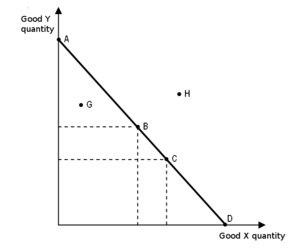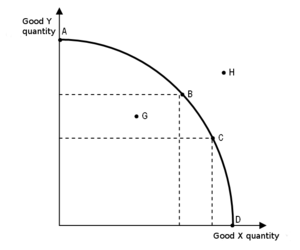Production capacity curve
| Production capacity curve |
|---|
| See also |
Production capacity curve presents graphically the maximum possible production of one good, given the size of the production of another good. The curve shows the various combinations of the quantities of goods or services which are possible to manufacture, where all available resources are fully used.
Production capacity curve plot
Graphical representation of the capacity curve may take the form of a straight or convex line.
Linear capacity plot
Shows quantity of goods, which company has to give up in exchange for a production of number of other good.
Convex capacity plot
Indicates that increasing production of one good, company has to give up more second good (or reducing the production of a particular good it get in return, produce ever larger amounts of other good). Concave of curve in relation to the origin of the coordinate system is a consequence of the law of diminishing returns. Moving on the curve from point A to B, B to C, C to D, we get decreasing numbers of good X, along greater production of good Y.
|
Convex production capacity plot |

Linear production capacity plot |
Analysis of plots
Production capacity curve separates from each other two sets: a combination of goods that are inefficient, but available (under the curve) and impossible combinations of goods (over the curve). The position at the point G, it's a situation where we do not use all the resources at our disposal at any given time. The combination at the point H is reached at the given level of resources, knowledge and technology. The H point may be achieved over a longer period of time as a result of technical progress. Points on the capacity curve (e.g. B, C) shows a situation where the available resources are used fully effectively. The transition from point A to B, B what C, etc. means the moving of productive resources (e.g. machines, manpower) from production of good Y to the production of good X.
Capacity curve is also called transformation curve, due to the fact that moving production and resources from one good to another is a kind of transformation of one good to another.
Examples of Production capacity curve
- Production capacity curve for manufacturing a product is a graph that shows the maximum possible production of one good, given the size of the production of another good. For example, a shoe manufacturing company may have a production capacity curve that shows the maximum possible number of shoes that can be manufactured given the amount of leather available for production.
- Production capacity curve for a service industry is a graph that shows the maximum possible number of services that can be provided given the amount of labor and materials available. For example, a catering company may have a production capacity curve that shows the maximum number of meals that can be prepared given the amount of food and labor available.
- Production capacity curve for a retail business is a graph that shows the maximum possible number of items that can be sold given the amount of inventory available. For example, a clothing store may have a production capacity curve that shows the maximum number of items that can be sold given the amount of clothing and accessories available in the store.
Advantages of Production capacity curve
Production capacity curve has numerous advantages, including:
- It helps to determine the maximum output that can be achieved with a given set of resources. This allows production managers to plan production levels and adjust resources as needed to maximize output.
- It enables a company to assess the capacity of its production facilities and identify potential bottlenecks in the production process. This helps to ensure that the resources are being used efficiently and that production is not being limited by any factor.
- It provides a visual representation of the potential output of a production facility, which can be used to compare different production processes and identify areas of improvement.
- It helps to identify and evaluate the different options available in terms of production capacity, so that a company can find the most cost-effective production strategy.
- It allows a company to forecast future demand and adjust the production capacity accordingly. This helps the company to better manage its resources and ensure that production is meeting customer requirements.
Limitations of Production capacity curve
Production capacity curve is a useful tool for understanding the maximum production levels of a given product, however, there are certain limitations to this approach. These limitations include:
- It assumes that all resources are used efficiently and are in full capacity, however, it does not account for the potential inefficiencies of the production process.
- It also assumes that all factors of production are available in sufficient quantities, which may not always be the case.
- It ignores the potential changes in prices or demand, which may affect the production capacity of a particular good.
- It does not account for the availability of technology or the level of competition in the market, which can limit the production of certain goods.
- Production capacity curves are also limited in their ability to accurately project future production levels, as they do not account for any fluctuations in the market or changes in technology.
- Production function: It is an equation that shows the relationship between the inputs used to produce a good or service (labor, capital, materials, etc.) and the output that is generated.
- Time-series analysis: It is a method of analyzing past data and predicting future trends. It involves analyzing data at regular intervals over a period of time, such as monthly or quarterly sales figures.
- Activity-based costing: It is a method of costing that assigns costs to activities based on the resources used to perform them. It helps to identify the cost drivers that are associated with an activity.
- Process flow analysis: It is a technique used to analyze and improve the workflow of a process. It involves mapping out each step of the process, identifying bottlenecks and areas of waste, and improving the efficiency of the process.
In summary, other approaches related to Production capacity curve include Production function, Time-series analysis, Activity-based costing, and Process flow analysis. All these methods help to analyze the resources used to produce a good or service and help to identify and improve areas of inefficiency in the production process.
References
- Kleindorfer, P. R., Singhal, K., & Wassenhove, L. N. (2005). Sustainable operations management. Production and operations management, 14(4), 482-492.
